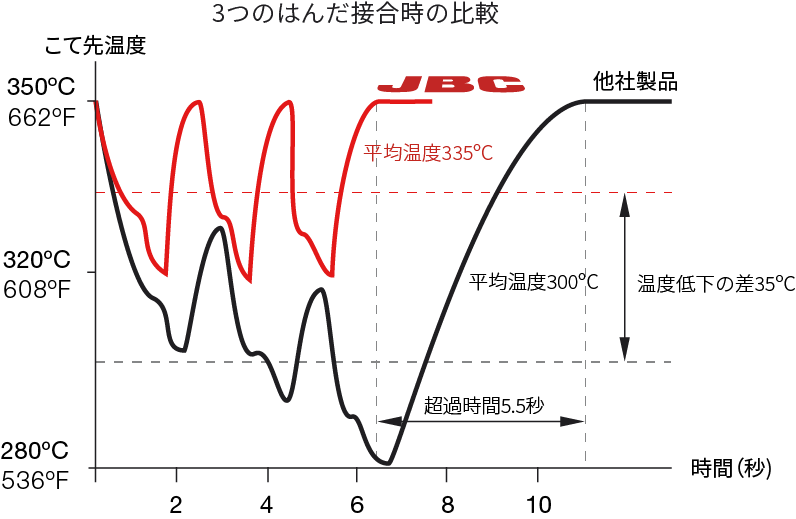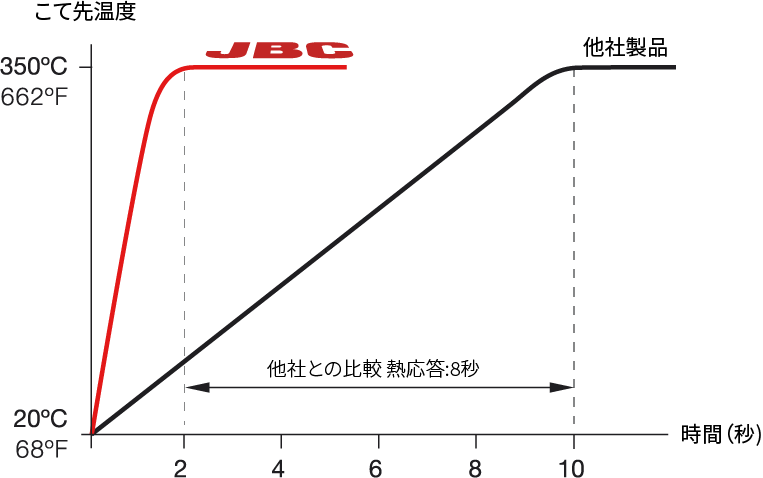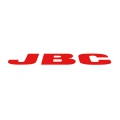FAQs
1 General Questions
JBC soldering irons are fourth-generation soldering technology.
We use one wire buried deep in the tip of the copper to “read and feed.” Our thermocouple and heating element wire are one in the same and are microprocessor driven over a sensor at 60 hertz utilizing up to 140 watts on demand in a very low mass cartridge.
This is why our thermal performance cannot be matched. It is technology compatible with todays needs, as well as tomorrows. Our competitors are using technology invented 20+ years ago with little advancement.
We have over a hundred distributors worldwide in all continents.
JBC started making soldering equipment in 1929 and has been focussing on delivering the best tools in the industry, since then.
Warranty does not cover product wear or misuse.
In order for the warranty to be valid, equipment must be returned, postage paid, to the dealer where it was purchased.
You can register your warranty within 30 days of purchase by filling in the following form.
2 Product Specifications
Always 1.
2-tool Control Unit has 2 connectors + 1 special connector for the desoldering pump, and 4-tool Control Unit has 4 connectors + 1 special connector for the desoldering pump.
Yes, you can.
When you purchase RMS Complete Rework Station you will not get them through. You will have to purchase them separately and don’t forget the stand for them!
You can change this password for another one.
If you enter 3 times an incorrect code, the station will give you an 8 digits number. Please contact JBC with that number and we will help you out.
When you are setting up your station, you will be requested to pick up the tool that you want to change the parameters of. Just grab it and select your temperatures.
3 Maintenance & Repair
Please contact your distributor or JBC directly.
Probably flux waste is on the metal part of the handle which prevents the tool from making good contact with the stand.
Clean it with alcohol or flux cleaner.
4 Consumables
It varies by the tip geometry, the thickness of the tip’s iron coating, the temperature settings, the solder, the flux used and the operator skills.
JBC features tips which can perform up to 100,000 solder joints.
The tip tinner / cleaner is a chemical method to clean and retin the tip at the same time.
It should be used only when alternative methods fail (i.e. sponge, brass) and a very active cleaning method is needed.
No, you are free to choose any temperature with any cartridge.
If desired the temperature can easily be locked at a fixed level.
No.
Even though you need 2 cartridges to operate the PA120, AM120 and the HT420, they are sold individually.
JBC prototype developers are constantly creating special cartridge profiles according to the requests of customers.
Have a look at the product range of products.
Follow the lines from the tool to the stand and the unit which runs the tools you require.
The desoldering pump is always purchased apart so that you can decide whether you prefer an electric or a compressed air pump.
However, if you purchase 2-Tool DDU Stations or 4-Tool DMU Stations with DR560, you will get an electric desoldering pump included.
Be sure that the cartridges are properly aligned and tightened.
There is a small flat head screw that locks in each cartridge located on the body of the tweezer. If this is not properly tightened, the station sees an open circuit, and will therefore provide no heat.
The combination of silver, more flux, and higher temperatures make for a “dirtier” soldering process.
Silver oxide and burnt flux are deposited on the tip. Make sure to use the lowest temperature possible, wipe your tip more frequently and use JBC lead free tip tinner (ref: TT-A) when the tip doesn’t wet anymore.
5 Soldering Temperatures
Our experience shows that 90% of solder joints using JBC tools can be performed successfully at 350ºC or less, in any case it is not recommended to exceed 370ºC.
It is possible because the tip has an extremely fast thermal response.
On a conventional iron’s tip, there is a strong drop in temperature while the tip is transferring the heat to the board. If the thermal response is slow, the tip does not have the time to recover the temperature, especially if a series of solder joint is performed.
This is the reason why the operator is used to select a higher temperature, resulting in short tip life and PCB / component damage.
· The tips last much longer because of reduced oxidation. This improves the wettability of the tip and therefore also the heat transfer efficiency.
· The flux does not burn directly on the tip but is activated while soldering. In this way, the tip does not turn dark so quickly and its wettability is better.
· The risk of damaging components and PCB through excessive heat transfer is minimized.
· The process quality is optimized because there are less rework issues and scraps.
The factory setting of 220ºC is adequate for most situations.
At this temperature oxidation is lowered to a minimum and ramp up to work temperature, when the tool is taken out of it’s stand, will be completed in about a second.
Since the technology is based on a microprocessor drive Advanced stations do not require calibration.
6 Cleaning Tips
Desoldering is a dirty task.
When using our DR Desoldering Iron, it is recommended that you have a spare “tube”, clean and set to go during the day. Simply unscrew the green end piece of the gun, remove it from the handle, take the tube off and replace it with the new one. This will allow you to continue working without stopping. Put aside 5-10 minutes at the end of a shift to use the extraction rod to take out the baffle and the filter in the glass or stainless steel tubes. Take a small wire brush and gently brush the solder off the baffle into a trash receptacle or hazardous waste container (if using leaded solder). Replace the baffle to the mark on the tube and insert a new white filter. You should periodically check the secondary filter at the front (or back, depending on the model) of the desoldering pump. Replace it when it looks dirty (discolored).
It is also a good idea to use the supplied drill bit tool to clean out the desoldering nozzles that you use to prevent buildup and clogging. The amount of usage your desoldering tool gets will determine the frequency of cleaning. Please see the manual for additional recommendations.
It depends on maintenance and on the technology of the soldering method.
A damp (not swamped) sponge is an efficient cleaning method if it is kept clean. It should be changed periodically and used with deionised water. Tip temperature partially decreases during contact with the sponge. This could be a disadvantage with older generations of soldering systems, where the iron does not have a very fast thermal response and takes several seconds to recover the working temperature.
The cleaning wire (brass) is an alternative to the sponge, needing less maintenance but does not decrease the temperature of the tip, which is why it is better suited to some handsoldering tools with low thermal response. A disadvantage to the brass wool is that it releases residues which may fall on the PCBs if there is no splashguard. The brass wool holder should be heavy enough to prevent it moving when being used, so the operator will not have to steady it with the other hand. The metal brush is a more aggressive method when cleaning the tip, but if used gently, it cleans the tip well with the least damage.
The tip tinner / cleaner is a chemical method for cleaning and retinning the tip at the same time. It should be used when the previous methods fail and a more active cleaning method is needed. You can also clean with JBC sand: you put the tip into the receptacle with the sand and turn it around. This method is advisable as a last resort.
Brass wool: Although less aggressive than the Inox Wool, it is easily subject to deterioration. It will cause metal particles and fibers to contaminate the working area. Customers have refused to use Brass Wool for this reason. Brass wool was first used in industry many years ago and it became standard use in industry and was used by many operators.
Inox Wool: It is more agressive than the Brass wool and so will require more care when being used. It is the most effective when used less aggressively and therefore minimizing the abrasions – Remember! Less Is Better. As well as being more effective, Inox is much more durable than Brass. It is more flexible, less fragile, and as a result, reduces the amount of particles and contamination of the work area. In tests we found it very resistant to breakage and it contained less than 10 times the amount of broken particles than in Brass wool.
JBC独自の
ヒーティングシステム
JBC独自のヒーティングシステムは最速で温度に到達したり、回復したりできます。
この革新的な技術は過度の熱を加えることによって部品を損傷するリスクを減らし、はんだ付けまたははんだ除去作業の質を向上させます。



